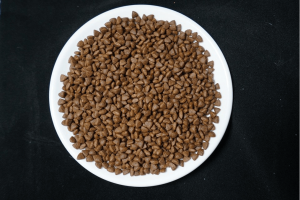You may easily get overwhelmed if you go down the pet food section of any big pet goods store or browse the shelves of a boutique pet food store. This is especially the case for puppy parents, especially first-time dog owners. How did it become so difficult? Dog food selections were considerably more restricted back in the day, and even responsible pet parents didn’t give a hoot about what went into their dog’s bowl.
The process may have become more complicated, but that’s a good thing. Greater ingredients, superior sourcing, and specific meal formulations all contribute to our puppies’ overall wellness. Identifying your puppy’s specific dietary requirements is just as essential as knowing what to give it.
Because every puppy is different, please visit your breeder or vet if you already have any specific concerns regarding your puppy’s diet, feeding regimen, or nutritional status.
A lot of pet parents find it challenging to make the best meal plan for their furry babies. Here’s a rough guide of what your pup will require at each step of its first year. Follow the link for more https://pets.webmd.com/dogs/feeding-time#1.
The feeding timeline
It’s essential to know how and what kind of food your tiny furry friend needs to grow strong.
Six to twelve weeks
Puppy food, a specifically prepared diet to satisfy the nutritional demands for proper growth, should be provided to growing puppies. Adult food deprives your puppy of essential nutrients. Dietary requirements are generally met with four feedings each day. By 8 to 9 weeks, more giant breeds must be offered dry meals, while tiny dogs must be fed 12 to 14 weeks.
Three to six months
Reduce the number of feedings from 4 to 3 per day at some point throughout this time. By 12 weeks, a puppy’s potbelly and tummy pooch should be gone. Continue to give puppy-size amounts until its body type develops if it is still wiggly at this age.
Six to twelve months
Start feeding twice a day. Spay and neuter or neutering reduce energy requirements significantly; transition from nutrient-rich puppy diet to adult meals following the surgery. Smaller dogs can transition at 7 to 9 months, whereas larger dogs at 12, 13, and even 14 months. It’s preferable to be on puppy chow almost too long than just not long enough, so err on the side of caution.
Adult dogs are usually fed two half-portions each day when they reach the age of one.
What should I feed my dog in terms of meals?
When it comes to canine feeding, there’s an adage that goes, “Watch the dog, not the dish.” Portion sizes should be determined by body condition rather than the quantity consumed or left in the dish. Portion sizes are determined by an individual’s body type, and metabolism and nutrient requirements differ from one dog to the next. Don’t be concerned if your puppy misses meals or picks at its bowl. It might indicate that it is ready to stop eating or that you have offered your furry friend too much food; in any case, simply lower the amount provided.
Also, if you’re training your dog with treats, make sure you modify the quantity you offer at meals. When using rewards for training, keep the treat as tiny as possible.
How often should I feed it?
Puppies, like human newborns, require many little meals each day of a diet developed specifically for their nutritional needs. The majority of dogs, but not all, eat their meals fast. Feed at regular intervals and in regular quantities to prevent fussy eating habits. Don’t keep food out for longer than 20 minutes.
Your breeder, as well as your veterinarian, will be a great source of information on both of these topics.
Is it worth it to spend a lot of money on puppy food?
Because premium dog treats have greater nutritional density, you may feed your dog less and get the same benefits. Furthermore, luxury meals have consistent component profiles, but budget brands’ composition might fluctuate from different batches.
The big dog-food firms invest substantially in product technology and growth to stay up with their competition, continuously updating recipes. Feeding quality meals to your dog puts you at the forefront of the technology of canine nutrition.
Is it OK for puppies to eat adult dog food?
If you want to know how much food to feed a puppy as well as what kind of meals it needs to have, you can look online for answers and discuss some options with your vet.
Puppies and older dogs require varying amounts of nutrients. Puppies require more micronutrients, proteins, and carbohydrates as they mature into adult dogs. They require a lot of calories to grow. Therefore you should get a high-quality food product for your pup.
Because a puppy’s mouth is tinier than an adult dog’s, its meal isn’t as large as adult kibble. Puppies should not be fed adult dog food since the kibble is bigger and thicker. Giving an adult dog meal to a puppy might harm its teeth, jawline, and general health.
Is it better to eat dry or wet food?
Many pet food manufacturers have collaborated with canine nutritionists to create specific formulations for both large and small-breed puppies.
Canned food is by far the costliest to provide, but it is also the most appealing to dogs. However, be wary of “all-meat” promises. To meet nutritional needs, your dog should eat a comprehensive, balanced diet. It’s possible that meat alone won’t be enough. One-serving packages of semi-moist food are available. It’s generally shaped like a hamburger.
The most cost-effective option is kibble, and the main manufacturers provide a comprehensive and balanced meal for all dogs. Dry food can be consumed directly from the bag.
Many dog owners believe that hard kibble has an oral hygiene benefit because the friction it creates helps keep the teeth and gums clean. Water or canned food can be used to wet kibble. Although optional, this addition may improve the taste of the cuisine.












